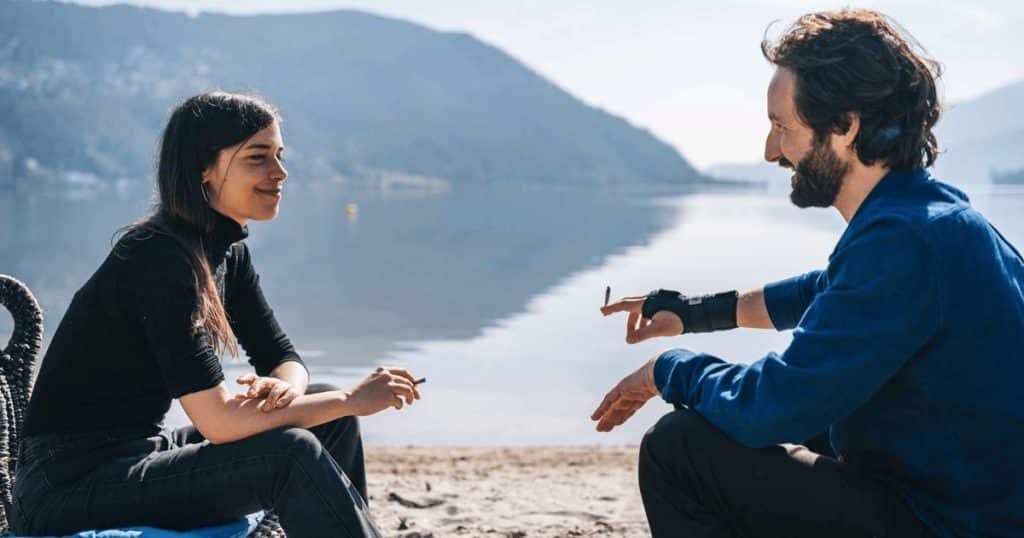What’s the difference between a cannabis traveler and a normal traveler? Emerging trends say there isn’t one. From cannabis cultivation tours to “wake and bake breakfast” hotels, American locations are learning that “canna-cations” are no longer exclusively for stoners. Another emerging trend is that this cannabis tourism sector seems to be largely pioneered by small businesses, with little to no effort on the part of mainstream and large businesses.
Adrienne’s Story
Adrienne is in her 40s. She is a makeup artist, and she grew up in Georgia, where cannabis is illegal. However, she has been a cannabis consumer since the age of 14. Her curiosity about purchasing cannabis legally drove her to suggest that she and her husband visit California on their vacation in 2018.
She had never been to a dispensary before and wanted a professional to show them around while they sit back and absorb all the information.
With this in mind, Adrienne scheduled a trip with Emerald Farm Tours, a San Francisco-based company that takes cannabis fans to local shops and offers private tours of indoor cannabis farms throughout the Bay Area. Their “canna-cation” cost around $1,500, which included a half-day tour, a good assortment of marijuana, and a hotel stay. She planned another trip with the same business a few months later, this time for a full-day excursion to an outdoor cannabis farm in Mendocino, about three hours north of San Francisco.
Where Cannabis Tourism Is Will Boom
Of course, although California is more widely known for – and has long been associated with – legal cannabis, it is certainly not America’s only option when looking to book a cannabis-centered vacation. Currently, 19 states and the District of Columbia have legalized recreational cannabis, with several more states expected to follow suit this year.
A welcome bonus of the spreading legalization of cannabis is the downturn in the stigma surrounding cannabis and cannabis use, which contributes to the booming cannabis tourism industry.
According to a Harris Poll conducted in May, more than two-thirds of American people (68%) now support adult use. Access to legal recreational cannabis is crucial to half of all millennials (50%) when picking a holiday destination, and more than four in ten (43%) say they’ve intentionally chosen a destination because cannabis is legal there.
Lack Of Mainstream Tourism Support
According to Victor Pinho, cofounder of Emerald Farm Tours, cannabis travel has been mostly disregarded by tourism boards and the industry at large, leaving millions of dollars on the table. “They’re tourists and they’re shopping—they’re here to spend money in the pot mecca,” he says, revealing that his average customer spends $300 to $400 at the dispensary during their visits, which is around three times the amount spent by locals.
Consider Colorado, where recreational cannabis has been legal for ten years and generated $423 million in tax revenue last year. Other than generic cannabis safety tips, regulatory standards, and other practical advice, the Colorado Tourism Office website offers little help for 420-friendly travelers. “Cannabis is not one of the key drivers of tourism to our state when compared to categories like outdoor recreation,” writes a Colorado tourism official via email, noting that no figures or reports on the number of travel or revenue are available.
However, the lack of mainstream support, while unfortunate, will not change the fact that cannabis tourism is a sector that is only in its infancy, with plenty of room for growth for those that choose to get on board.
While the state of Colorado may not be actively attempting to entice tourists interested in experiencing its cannabis culture, its entrepreneurs are. The Patterson Inn, a 9-bedroom boutique hotel at 420 E. 11 Street in Denver, will shortly house the city’s first licensed cannabis use lounge at a hotel. By the end of the year, owner Chris Chiari expects his 1,000-square-foot club, dubbed the 420 Suite, to be open to paying hotel guests. “I like to describe it as Soho House with cannabis,” Chiari explains.
Other enterprises taking advantage of this opening in the cannabis industry are Cultivar and Modesto who came together to create the MoTown CannaPass, a passport-style reward program that helps visitors find a range of restaurants, events, and cannabis stores in the city. According to Aaronson, the MoTown CannaPass increased traffic to local cannabis merchants by 11% right away, as well as overnight stays to Modesto.
“We wanted to take this opportunity to say, ‘Hey, if cannabis is your thing, and you’re here, we have legal retail outlets,'” Aaronson adds. “And we have experiences that are comparable to those found in a brewpub or wine bar.” They’re all regulated in the same way. For each, you should have a designated driver. Any and all visitors are welcome. “Place your cash here.”
Benefits For Everyone
Other businesses benefit from the legalization of cannabis as well, because the influx of tourists will, of course, not limit their vacation spending to cannabis-related activities.
Forbes forecasts that tourists drove up to $4.5 billion of the $25 billion in legal cannabis sales in 2021, putting an additional $12.6 billion into restaurants, hotels, attractions, and other shops, as well as state and municipal tax budgets. According to Beau Whitney, founder and chief economist at Whitney Economics, a leader in cannabis and hemp business consultancy, every dollar spent at a cannabis retailer has a multiplier effect, with an additional $2.80 infused into the local economy.
Cannabis Tourism Is Not Only For Stoners
According to a report from the Cannabis Travel Association International (CTAI), an industry trade group, the typical cannabis traveler looks less like a stereotypical stoner and more like any other upscale vacationer—one who is just as likely to be female as male, skewing toward millennials or younger (63%), with a college degree (59%), a job (82%), and an average household income of $87,000. “By 2025, millennials will account for half of all passengers in the United States,” says Brian Applegarth, the organization’s founder. “And, in comparison to today’s stigmatized industry leaders, their connection with cannabis smoking is extremely accepted.”
California has emerged as the heart of cannabis tourism for the time being, with a handful of other destinations across the Golden State lately launching their own programs. As cannabis legalization continues its slow progression through each state, as the stigmatization of cannabis continues to be dismantled, and as more businesses hop on this huge cannabis tourism opportunity – we’re sure this is a sector that’s soon to be bursting.
While it’s slightly disappointing, for both the cannabis industry and the tourism industry – whether they know it to be yet – that mainstream tourism enterprises have not caught on to this trend, we don’t see this stopping small businesses from taking the tourism ball and running with it.
Enjoyed that first hit? Come chill with us every week at the Friday Sesh for a freshly packed bowl of the week’s best cannabis news!
















